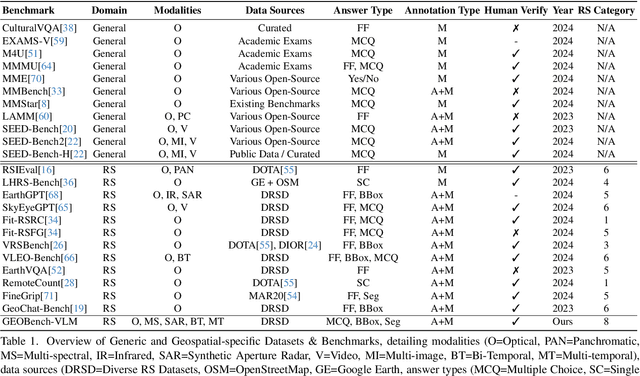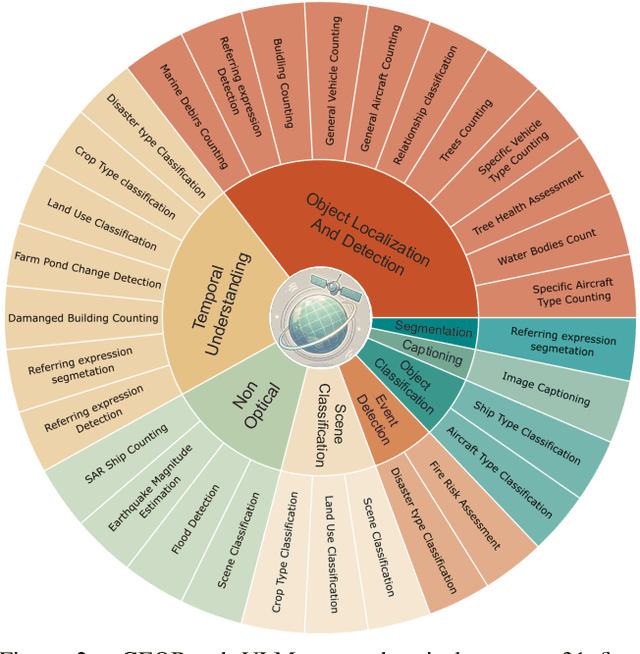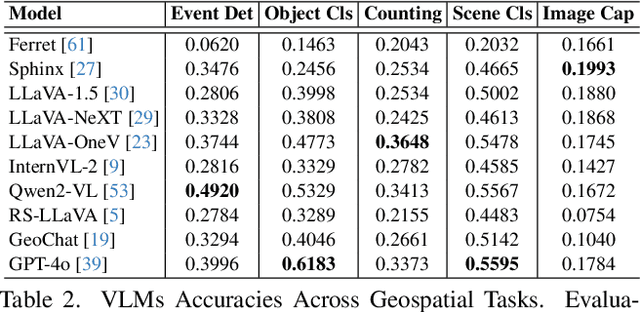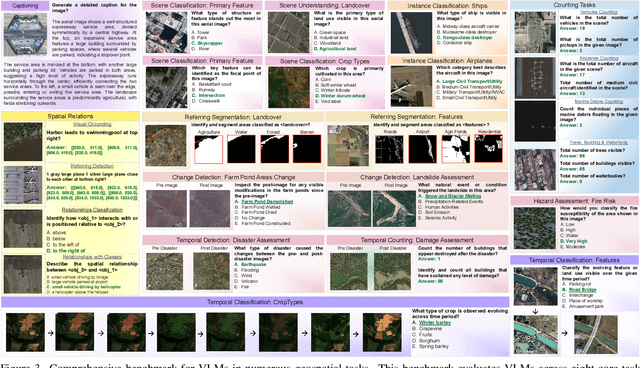Muhammad Akhtar Munir
TerraFM: A Scalable Foundation Model for Unified Multisensor Earth Observation
Jun 06, 2025Abstract:Modern Earth observation (EO) increasingly leverages deep learning to harness the scale and diversity of satellite imagery across sensors and regions. While recent foundation models have demonstrated promising generalization across EO tasks, many remain limited by the scale, geographical coverage, and spectral diversity of their training data, factors critical for learning globally transferable representations. In this work, we introduce TerraFM, a scalable self-supervised learning model that leverages globally distributed Sentinel-1 and Sentinel-2 imagery, combined with large spatial tiles and land-cover aware sampling to enrich spatial and semantic coverage. By treating sensing modalities as natural augmentations in our self-supervised approach, we unify radar and optical inputs via modality-specific patch embeddings and adaptive cross-attention fusion. Our training strategy integrates local-global contrastive learning and introduces a dual-centering mechanism that incorporates class-frequency-aware regularization to address long-tailed distributions in land cover.TerraFM achieves strong generalization on both classification and segmentation tasks, outperforming prior models on GEO-Bench and Copernicus-Bench. Our code and pretrained models are publicly available at: https://github.com/mbzuai-oryx/TerraFM .
ThinkGeo: Evaluating Tool-Augmented Agents for Remote Sensing Tasks
May 29, 2025Abstract:Recent progress in large language models (LLMs) has enabled tool-augmented agents capable of solving complex real-world tasks through step-by-step reasoning. However, existing evaluations often focus on general-purpose or multimodal scenarios, leaving a gap in domain-specific benchmarks that assess tool-use capabilities in complex remote sensing use cases. We present ThinkGeo, an agentic benchmark designed to evaluate LLM-driven agents on remote sensing tasks via structured tool use and multi-step planning. Inspired by tool-interaction paradigms, ThinkGeo includes human-curated queries spanning a wide range of real-world applications such as urban planning, disaster assessment and change analysis, environmental monitoring, transportation analysis, aviation monitoring, recreational infrastructure, and industrial site analysis. Each query is grounded in satellite or aerial imagery and requires agents to reason through a diverse toolset. We implement a ReAct-style interaction loop and evaluate both open and closed-source LLMs (e.g., GPT-4o, Qwen2.5) on 436 structured agentic tasks. The benchmark reports both step-wise execution metrics and final answer correctness. Our analysis reveals notable disparities in tool accuracy and planning consistency across models. ThinkGeo provides the first extensive testbed for evaluating how tool-enabled LLMs handle spatial reasoning in remote sensing. Our code and dataset are publicly available
O-TPT: Orthogonality Constraints for Calibrating Test-time Prompt Tuning in Vision-Language Models
Mar 15, 2025Abstract:Test-time prompt tuning for vision-language models (VLMs) is getting attention because of their ability to learn with unlabeled data without fine-tuning. Although test-time prompt tuning methods for VLMs can boost accuracy, the resulting models tend to demonstrate poor calibration, which casts doubts on the reliability and trustworthiness of these models. Notably, more attention needs to be devoted to calibrating the test-time prompt tuning in vision-language models. To this end, we propose a new approach, called O-TPT that introduces orthogonality constraints on the textual features corresponding to the learnable prompts for calibrating test-time prompt tuning in VLMs. Towards introducing orthogonality constraints, we make the following contributions. First, we uncover new insights behind the suboptimal calibration performance of existing methods relying on textual feature dispersion. Second, we show that imposing a simple orthogonalization of textual features is a more effective approach towards obtaining textual dispersion. We conduct extensive experiments on various datasets with different backbones and baselines. The results indicate that our method consistently outperforms the prior state of the art in significantly reducing the overall average calibration error. Also, our method surpasses the zero-shot calibration performance on fine-grained classification tasks.
AirCast: Improving Air Pollution Forecasting Through Multi-Variable Data Alignment
Feb 25, 2025Abstract:Air pollution remains a leading global health risk, exacerbated by rapid industrialization and urbanization, contributing significantly to morbidity and mortality rates. In this paper, we introduce AirCast, a novel multi-variable air pollution forecasting model, by combining weather and air quality variables. AirCast employs a multi-task head architecture that simultaneously forecasts atmospheric conditions and pollutant concentrations, improving its understanding of how weather patterns affect air quality. Predicting extreme pollution events is challenging due to their rare occurrence in historic data, resulting in a heavy-tailed distribution of pollution levels. To address this, we propose a novel Frequency-weighted Mean Absolute Error (fMAE) loss, adapted from the class-balanced loss for regression tasks. Informed from domain knowledge, we investigate the selection of key variables known to influence pollution levels. Additionally, we align existing weather and chemical datasets across spatial and temporal dimensions. AirCast's integrated approach, combining multi-task learning, frequency weighted loss and domain informed variable selection, enables more accurate pollution forecasts. Our source code and models are made public here (https://github.com/vishalned/AirCast.git)
EarthDial: Turning Multi-sensory Earth Observations to Interactive Dialogues
Dec 19, 2024



Abstract:Automated analysis of vast Earth observation data via interactive Vision-Language Models (VLMs) can unlock new opportunities for environmental monitoring, disaster response, and resource management. Existing generic VLMs do not perform well on Remote Sensing data, while the recent Geo-spatial VLMs remain restricted to a fixed resolution and few sensor modalities. In this paper, we introduce EarthDial, a conversational assistant specifically designed for Earth Observation (EO) data, transforming complex, multi-sensory Earth observations into interactive, natural language dialogues. EarthDial supports multi-spectral, multi-temporal, and multi-resolution imagery, enabling a wide range of remote sensing tasks, including classification, detection, captioning, question answering, visual reasoning, and visual grounding. To achieve this, we introduce an extensive instruction tuning dataset comprising over 11.11M instruction pairs covering RGB, Synthetic Aperture Radar (SAR), and multispectral modalities such as Near-Infrared (NIR) and infrared. Furthermore, EarthDial handles bi-temporal and multi-temporal sequence analysis for applications like change detection. Our extensive experimental results on 37 downstream applications demonstrate that EarthDial outperforms existing generic and domain-specific models, achieving better generalization across various EO tasks.
GEOBench-VLM: Benchmarking Vision-Language Models for Geospatial Tasks
Nov 28, 2024



Abstract:While numerous recent benchmarks focus on evaluating generic Vision-Language Models (VLMs), they fall short in addressing the unique demands of geospatial applications. Generic VLM benchmarks are not designed to handle the complexities of geospatial data, which is critical for applications such as environmental monitoring, urban planning, and disaster management. Some of the unique challenges in geospatial domain include temporal analysis for changes, counting objects in large quantities, detecting tiny objects, and understanding relationships between entities occurring in Remote Sensing imagery. To address this gap in the geospatial domain, we present GEOBench-VLM, a comprehensive benchmark specifically designed to evaluate VLMs on geospatial tasks, including scene understanding, object counting, localization, fine-grained categorization, and temporal analysis. Our benchmark features over 10,000 manually verified instructions and covers a diverse set of variations in visual conditions, object type, and scale. We evaluate several state-of-the-art VLMs to assess their accuracy within the geospatial context. The results indicate that although existing VLMs demonstrate potential, they face challenges when dealing with geospatial-specific examples, highlighting the room for further improvements. Specifically, the best-performing GPT4o achieves only 40\% accuracy on MCQs, which is only double the random guess performance. Our benchmark is publicly available at https://github.com/The-AI-Alliance/GEO-Bench-VLM .
Efficient Localized Adaptation of Neural Weather Forecasting: A Case Study in the MENA Region
Sep 11, 2024Abstract:Accurate weather and climate modeling is critical for both scientific advancement and safeguarding communities against environmental risks. Traditional approaches rely heavily on Numerical Weather Prediction (NWP) models, which simulate energy and matter flow across Earth's systems. However, heavy computational requirements and low efficiency restrict the suitability of NWP, leading to a pressing need for enhanced modeling techniques. Neural network-based models have emerged as promising alternatives, leveraging data-driven approaches to forecast atmospheric variables. In this work, we focus on limited-area modeling and train our model specifically for localized region-level downstream tasks. As a case study, we consider the MENA region due to its unique climatic challenges, where accurate localized weather forecasting is crucial for managing water resources, agriculture and mitigating the impacts of extreme weather events. This targeted approach allows us to tailor the model's capabilities to the unique conditions of the region of interest. Our study aims to validate the effectiveness of integrating parameter-efficient fine-tuning (PEFT) methodologies, specifically Low-Rank Adaptation (LoRA) and its variants, to enhance forecast accuracy, as well as training speed, computational resource utilization, and memory efficiency in weather and climate modeling for specific regions.
Improving Single Domain-Generalized Object Detection: A Focus on Diversification and Alignment
May 23, 2024



Abstract:In this work, we tackle the problem of domain generalization for object detection, specifically focusing on the scenario where only a single source domain is available. We propose an effective approach that involves two key steps: diversifying the source domain and aligning detections based on class prediction confidence and localization. Firstly, we demonstrate that by carefully selecting a set of augmentations, a base detector can outperform existing methods for single domain generalization by a good margin. This highlights the importance of domain diversification in improving the performance of object detectors. Secondly, we introduce a method to align detections from multiple views, considering both classification and localization outputs. This alignment procedure leads to better generalized and well-calibrated object detector models, which are crucial for accurate decision-making in safety-critical applications. Our approach is detector-agnostic and can be seamlessly applied to both single-stage and two-stage detectors. To validate the effectiveness of our proposed methods, we conduct extensive experiments and ablations on challenging domain-shift scenarios. The results consistently demonstrate the superiority of our approach compared to existing methods. Our code and models are available at: https://github.com/msohaildanish/DivAlign
Domain Adaptive Object Detection via Balancing Between Self-Training and Adversarial Learning
Nov 08, 2023Abstract:Deep learning based object detectors struggle generalizing to a new target domain bearing significant variations in object and background. Most current methods align domains by using image or instance-level adversarial feature alignment. This often suffers due to unwanted background and lacks class-specific alignment. A straightforward approach to promote class-level alignment is to use high confidence predictions on unlabeled domain as pseudo-labels. These predictions are often noisy since model is poorly calibrated under domain shift. In this paper, we propose to leverage model's predictive uncertainty to strike the right balance between adversarial feature alignment and class-level alignment. We develop a technique to quantify predictive uncertainty on class assignments and bounding-box predictions. Model predictions with low uncertainty are used to generate pseudo-labels for self-training, whereas the ones with higher uncertainty are used to generate tiles for adversarial feature alignment. This synergy between tiling around uncertain object regions and generating pseudo-labels from highly certain object regions allows capturing both image and instance-level context during the model adaptation. We report thorough ablation study to reveal the impact of different components in our approach. Results on five diverse and challenging adaptation scenarios show that our approach outperforms existing state-of-the-art methods with noticeable margins.
Cal-DETR: Calibrated Detection Transformer
Nov 06, 2023Abstract:Albeit revealing impressive predictive performance for several computer vision tasks, deep neural networks (DNNs) are prone to making overconfident predictions. This limits the adoption and wider utilization of DNNs in many safety-critical applications. There have been recent efforts toward calibrating DNNs, however, almost all of them focus on the classification task. Surprisingly, very little attention has been devoted to calibrating modern DNN-based object detectors, especially detection transformers, which have recently demonstrated promising detection performance and are influential in many decision-making systems. In this work, we address the problem by proposing a mechanism for calibrated detection transformers (Cal-DETR), particularly for Deformable-DETR, UP-DETR and DINO. We pursue the train-time calibration route and make the following contributions. First, we propose a simple yet effective approach for quantifying uncertainty in transformer-based object detectors. Second, we develop an uncertainty-guided logit modulation mechanism that leverages the uncertainty to modulate the class logits. Third, we develop a logit mixing approach that acts as a regularizer with detection-specific losses and is also complementary to the uncertainty-guided logit modulation technique to further improve the calibration performance. Lastly, we conduct extensive experiments across three in-domain and four out-domain scenarios. Results corroborate the effectiveness of Cal-DETR against the competing train-time methods in calibrating both in-domain and out-domain detections while maintaining or even improving the detection performance. Our codebase and pre-trained models can be accessed at \url{https://github.com/akhtarvision/cal-detr}.
 Add to Chrome
Add to Chrome Add to Firefox
Add to Firefox Add to Edge
Add to Edge